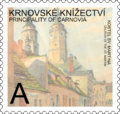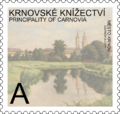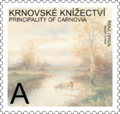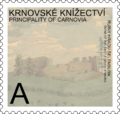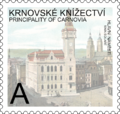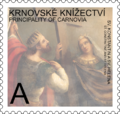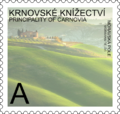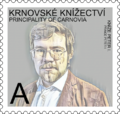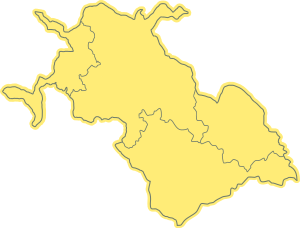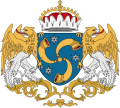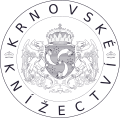Principality of Carnovia
| Motto: Spravedlnosti bude zadosti učiněno (Czech) Justice shall be done (English) Justitia fiet (Latin) | |
| Anthem: Požehnaný budiž Krnov (Czech) Blessed be Carnovia (English) | |
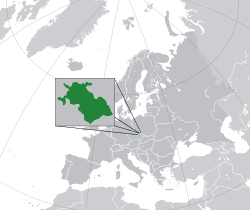 Claimed area according to the historical sprawl | |
| Status | Active |
| Location | Central Europe |
| Capital and largest city | Carnovia city |
| Official languages | |
| Recognised national languages | Czech |
| Recognised regional languages | Czech, Polish |
| Ethnic groups | Czech, Polish |
| Religion | Secular state |
| Demonym(s) | Carnovian |
| Government | unitary Constitutional monarchy |
• Prince | Peter I of Carnovia |
| Legislature | Princely Council |
| Independence from the Czech Republic | |
• Establishment of Duchy of Carnovia | 1377 |
• Establishment of Principality of Carnovia | 21 November 2021 |
| Area | |
• | 203 km2 (78 sq mi) (215) |
• Water (%) | 0 |
| Population | |
• Estimate | 10+ |
| HDI (2022) | very high |
| Currency | Carnovian koruna (CRK) |
| Time zone | UTC+1 (CET) |
• Summer (DST) | UTC+2 (CEST) |
| Date format | mm/dd/yyyy |
| Driving side | right |
| Calling code | +420 |
| GUM 3-letter code | CRN |
| IMSO 1 code | CRN |
| Internet TLD | .crn (proposed) |
| Part of a series on |
| Carnovia |
|---|
 |
| General |
| Constitution of Carnovia • Flag of Carnovia • Collection of regulations |
| Politics |
| Government of Carnovia • Princely Council of Carnovia • Monarchy of Carnovia |
| Districts |
|
|
The Principality of Carnovia (Czech: Krnovské knížectví) also known by its short-form name, Carnovia (Czech: Krnov) is a de facto autonomous region that claims to be a sovereign state, commonly known as a micronation. It is successor state to Archduchy of Egeria and was formed on 21 November 2021. Located in the Czech Republic and bordered by Poland from east in Central Europe. The nation is comprised of four regional territories bordering the Czech Moravian-Silesian region. The total surface area of Carnovia is 203 km2 with four districts established: Capital, Branov District, Olbernia District, Karlovice District. It is bordered by Poland to the east and Czech Republic to the west. The nation's capital and largest city is Carnovia [a] (Czech: Krnov). The official language of principality is Czech, Slovak and English. In addition Polish is spoken and understood by many residents.
The principality is governed under a form of constitutional monarchy, with Prince Peter I as head of state, who wields immense political power despite his constitutional status such as issuing princely decrees, so called the by-law regulations. The Prime Minister, who is the head of government, can be either a Czech or a Slovak citizen, [b][1] but preferable is Carnovian citizen. Parliament consists of only one chamber called Princely Council, which has 20 deputies one of them being the Chairman of Princely Council, who oversees the proceedings.
Many similarities and history is shared with Czech republic and former Lands of Bohemian crown and also with former Archduchy of Egeria. Carnovia uses czech language as its primary language, despite declaring independence and having a bad political relations with its former mother state, Carnovia acknowledges czech laws. However the self-determination of nation is superior than honoring mother state. On the basis of self-determination and right to choose to have any citizenship, Carnovia and her citizens have made claim. Principality of Carnovia declared independence on 21 November 2021 as successor state of Archduchy of Egeria. Carnovia is as well successor state of Duchy of Carnovia, which existed in years 1377 - 1849. Historical context and existence of Carnovia is basis of the nowadays claim of Principality of Carnovia.
Carnovia is developing country with almost no economic resources as it does not collect taxes and does not export any goods. However Government with help of Carnovian National Bank and postal service draft plans to start the economy by first step valorizing the currency Carnovian koruna. Although principality has the minimum GDP it ranks high on the Human Development Index, offering social security and a Universal Healthcare system. Carnovia is member state of Grand Unified Micronational.
History
Etymology
The Principality of Carnovia (Latin: Principatus Karnoviensis) is called Krnovské knížectví or simply Krnov. German Term Fürstentum Jägerndorf. The name of the Principality was choosed in attempt to build on heritage of Principality of Carnovia, which lasted from 1377 until 1849. The right to use this name grants us The document of Declaration of Independence, which mentions pursuit for restoration Carnovia state. The first documented name Kyrnow dates from 1240 and is derived from the personal name Krn , using the possessive suffix -ov, Silesian: Karńůw (Carnovia) . In translation, the name meant "Krn's property (castle)" [2] The German name Jegerdorf ("hunting village") is first recorded in 1253, it was probably chosen for its phonetic proximity to the Czech name. In 1281, the name Jegerndorf appeared, from which the later Jägerndorf evolved. The Latin designation Carnovia , which originated from the Czech model, dates from 1316 as "Karnovia".
First Principality 1377-1849

The province had been established in 1269 on lands which until then had been part of the Bohemian Margraviate of Moravia, when King Ottokar II of Bohemia vested his natural son Nicholas I with Opava. Together with the adjacent Duchy of Racibórz, it was under the direct rule of a cadet branch of the royal Přemyslid dynasty—unlike most other Silesian duchies ruled by the Silesian Piasts, who nevertheless in large part also had become Bohemian vassals in 1327. Nicholas retained Opava after the last Přemyslid ruler of Bohemia, King Wenceslaus III, was killed in 1306. In the following struggle for the Bohemian throne, he backed the claims of the Luxembourg candidate John the Blind, who in turn enfeoffed his son and successor Nicholas II with the Duchy of Opava in 1318. In 1337, Nicholas II also received the neighbouring Duchy of Racibórz upon the death of the last Piast duke Leszek.
When Duke Nicholas II died in 1365, his eldest son John I inherited the Duchy of Racibórz, while the Duchy of Opava from 1367 was ruled jointly by him and his younger brothers Nicholas III, Wenceslaus I and Přemek I. When in 1377 the brothers finally divided their Opava heritage, the eldest, John I, received the newly established Duchy of Krnov [c] (English: Carnovia) together with the Bruntál estates. Upon his death in 1380/82, Racibórz, Krnov and Bruntál were inherited by his elder son John II "the Iron".
In 1384, Duke John II sold Krnov to the Piast duke Władysław of Opole, who ceded it to the Luxembourg margrave Jobst of Moravia in 1390. After Jobst had died in 1411, his cousin Emperor Sigismund pawned Krnov to the Piast duke Louis II of Brieg, but in 1422 again ceded it to John II, who could redeem the pledge. Two years later, the duchy was inherited by his sons Wenceslaus II and Nicholas V, who ruled jointly until 1437, when Nicholas received Krnov together with Bruntál, Pless, Rybnik, Loslau, and Sohrau. Upon his death in 1452, Krnov (English: Carnovia) and Loslau fell to his elder son John IV, while Rybnik, Sohrau and Pless fell to his younger brother Wenceslaus III.
The Přemyslid dukes finally lost Krnov during the Bohemian–Hungarian War in 1474 to Matthias Corvinus, then anti-king of Bohemia, who had John IV captured and arrested. After John's death in 1483, his sister Barbara, consort of Duke Jan IV of Oświęcim, tried to regain the duchy; however, Vladislav II Jagiellon, having prevailed as Bohemian king, had no intention to return the seized duchy but enfeoffed his chancellor Johann von Schellenberg with Krnov (English: Carnovia) instead. An agreement was reached in 1492, when Barbara's daughter Helena married Schellenberg's son George.

In 1523, George of Schellenberg had to sell Krnov to the Hohenzollern margrave George of Brandenburg-Ansbach, who could rely on the Hungarian inheritance of his consort Beatrice de Frangepan, widow of Matthias Corvinus. From 1532 the margrave ruled over all Upper Silesia, when he also inherited the Duchy of Opole and Racibórz from the Piast duke Jan II the Good. He had Krnov Castle rebuilt and introduced the Protestant Reformation in Silesia, having the local Teutonic Knights, Franciscans and Minorites expelled. The increasing power of the Protestant House of Hohenzollern in the Silesian crown lands was suspiciously eyed by Ferdinand I of Habsburg, Bohemian king since 1526. Nevertheless, George as well as his son Margrave George Frederick, who ruled from 1543, were able to keep the duchy. The conflict aggravated when George Frederick died childless in 1603 and bequested Krnov to his cousin Elector Joachim III Frederick of Brandenburg, who gave it to his son Johann Georg in 1607. The Habsburg rulers regarded the duchy a reverted fief and after the Bohemian Revolt and the 1620 Battle of White Mountain Emperor Ferdinand II confiscated the Hohenzollern possessions in his Bohemian lands.[3] Ferdinand's loyal supporter Prince Karl I of Liechtenstein, Duke of Opava since 1613, received Krnov. Both duchies were merged in 1623 and subjected to Counter-Reformation.
The House of Hohenzollern never withdrew the claims and more than one hundred years later, the Krnov and Racibórz possessions were a pretext for the Prussian king Frederick the Great to start the First Silesian War, ending with the annexation of most of Silesia according to the Treaty of Breslau in 1742. While a small northern part was merged into the now Prussian Duchy of Opole, the bulk of Krnov remained with the Bohemian Crown as part of Austrian Silesia. Re-organised as the Krnov District (Czech: Krnovský kraj) from 1751, it was finally dissolved after the 1848 Revolution, when Austrian Silesia was raised to the status of a Cisleithanian crown land.
Second Principality 2021

The Principality of Carnovia was formed on 21 November 2021 by declaration of independence by prince Peter I of Carnovia and Princely Council in Carnovia (city). There were many reasons that led to the decision to break away from the Czech Republic and these were mainly the country's strong political instability, the decline of democracy and freedom, and above all the failure to meet basic legal standards in the past. All of these factors have initiated the prince's interest in intervening to create a new environment where citizens are not part of a collapsing state apparatus. Before it came to the actual declaration of autonomy of the Principality of Carnovia, it was under the territorial administration of the Czech Republic. Carnovia is also a succesor state of Egeria and efforts to become independent in the past, unfortunately these efforts have been wasted as its own citizens have lost interest in continuing. One of the main reasons was the location of Egeria and the impossibility of gaining real self-government in such an area. After some time of inactivity, however, the decision was made to establish Carnovia with claim that would flow its basis also from historical sources.
Governance

The Principality of Carnovia is a parliamentary monarchy where the Government exercises power on behalf of the sovereign, now Prince Peter I of Carnovia, who by tradition holds all the executive power. The prince is the highest authority in the state. The state is governed by a Constitution[4] approved by the Princely Council and the Prince. The Government is responsible to the Princely Council and is formed by whoever is the leader of the political party that has a majority after the Princely Council elections or can win that majority within the multi-party coalition. The Prince of the Carnovia Principality has extensive formal powers, but his role is primarily (though not exclusively) ceremonial. He is the integral element of the council, and it is he who gives it, in a solemn act, the power to meet and make laws. No law goes into effect until it's signed by the Prince. The legislative power is the Princely Council, which does not support any other form of legislature.
Legislature
The Princely Council has legislative power and has three functions: representing the electorate, making laws, and overseeing the government via hearings and inquiries. It alone possesses legislative supremacy and thereby ultimate power over all other political bodies in the Carnovia. It is necessary to obtain more than 50% of the vote for a law, and more than 60% of the votes for constitutional laws. The Princely Council has the power to declare a state of war and martial law. Assuming corruption or any other offense is proven to a public official, whatever position he is stripped of all mandates. The Princely Council cannot be dissolved. Any member of the Council may be removed.
Executive

The Government exercises executive power in the Principality of Carnovia. The government is led by prime minister, who selects all the other ministers. The prime minister and their most senior ministers belong to the supreme decision-making committee, known as the Cabinet. Ministers are responsible to the Princely Council. There are at the moment 7 Ministries following: Ministry of interior, Ministry of foreign affairs, Ministry of justice, Ministry of finance, Ministry of health, Ministry of defence, Ministry of culture.
The Prime minister presides over the Government, holds the executive power that is bestowed on him through the Prince and selects ministers and advises the sovereign in exercising much of the princedom's prerogative. Given that modern prime ministers hold office on the basis of their ability to command the confidence of the House of Commons, they usually sit as an MP and lead the largest party or coalition in the House.
The Prince is a head of the state and holds executive power and is also involved in the creation of new laws, his function is to pass laws but he can also propose them. The archduke has veto power. If a bill wants to be drafted and enacted, it must get more than 50% of the vote, more than 60% for constitutional bills. The Prince convenes a session of the Princely Council. It can issue so-called Princely decrees, which must comply with the legal system of the country, i.e. they are sub-statutory regulations.
Law and courts
The Principality of Carnovia is unitary state, with a civil law system based on the continental type, rooted in Germanic legal culture. The basis of the legal system is the Constitution of the Principality of Carnovia adopted in 2021, which can be found in Collection of regulations of Carnovia Principality, this collection gives an overview of all active regulations issued by Princely Council, Government, Prince and Districts to citizens, but also tourists, to know how to behave and abide valid laws in Carnovia. The court system includes district, county, and supreme courts and is divided into civil, criminal, and administrative branches. The Carnovia judiciary has a triumvirate of supreme courts. The Constitutional Court consists of 5 constitutional judges and oversees violations of the Constitution by either the legislature or by the government. The Supreme Court is formed of 20 judges and is the court of highest appeal for most legal cases heard in the Carnovia. The Supreme Administrative Court decides on issues of procedural and administrative propriety. It also has jurisdiction over certain political matters, such as the formation and closure of political parties, jurisdictional boundaries between government entities, and the eligibility of persons to stand for public office.
Political parties
Political parties are allowed. Each political party runs at the expense of state resources, and the campaign is therefore run by a state initiative, where, all conditions being met, political parties or individuals are provided with campaign funds. The own-initiative campaign is severely restricted on the grounds that every idea and agenda should be equal, regardless of whether they are a party of government or a non-parliamentary party.
| Party | Logo | Chair | Political position | Ideology | Government x opposition | Seats in parliament | |
|---|---|---|---|---|---|---|---|
| KLKD Carnovian Christian Democratic League |

|
Peter I of Carnovia | Centre-left | Christian democracy, Social democracy, Monarchism | Government | 20 / 20
| |
Economy
The Principality of Carnovia is currently developing its own currency Carnovian koruna, which will be printed by National bank with help of Postage service as they print valuable papers. National wealth is held in cryptocurrency as it is part of program of Micronational society of economic cooperation, organization that takes the inciative to bring real economics into micronations through uniting nations in common goal of creating stable economic system.
Administrative divisions
Municipal jurisdiction / lower administrative districts
There are many municipalities and towns in the Principality, which take care of lower administrative administration and are headed by municipal councils elected by secret ballot in direct elections, according to the law. each municipality has a district of administrative and cadastral jurisdiction according to assessments from the times when Carnovia was not a sovereign state. Municipalities and their representatives exercise such transfer of state power as has been transferred to them from a higher administrative district.
Districts / higher administrative districts
Carnovia is unitary state with 4 adiministrative districts,[5] which are collectively referred to as Okresy. They hold the highest transferred competence right after the state district and are above all municipalities. Districts are administered by district assemblies by secret ballot in direct elections.
Districts:Carnovia (city), Branov District, Olbernia District, Karlovice District.
| Flag | Coat of Arms | Name | District code | District capital | Population | Legislature body |
|---|---|---|---|---|---|---|
| Disctricts | ||||||
| Capital | KNV | 0 registered citizens | City Council of Carnovia | |||
| Branov District | OBN | Brantice | 0 registered citizens | District Council of Branov | ||
| Olbernia District | OLN | Albrechtice | 0 registered citizens | District Council of Olbernia | ||
| Karlovice District | OKC | Vrbno pod Pradědem | 0 registered citizens | District Council of Karlovice | ||
National symbols
The National symbols of the Carnovia[6] are the national flag - the tricolor (blue, yellow, white), the princely standard, the small Coat of arms, the Grand Coat of arms, the seal, the linden and linden leaves, the oak and oak leaves, the golden headed griffin, the national anthem.
-
National Flag
-
Princely Standard
-
Great Coat of arms
-
Small Coat of arms
-
Seal
-
Linden leaves
-
National Anthem
State citizenship

Carnovia officially provides its citizens with digital identification card which works on the basis of QR code and ID number both being in database of Ministry of interior. Citizens have both rights that are secured by Constitution and obligations as loyalty to the state, the commitment to its defense, the performance of certain functions to which it is called, and the observance of the laws of the state etc. In Carnovia it is permitted to have multiple citizenships. The citizenship can be acquired: By birth, by adoption, by determining paternity, by granting.
Applying for citizenship
For those, who are interested in applying for state citizenship of Carnovia it is important to know that you are establishing a legal relation with Carnovia as citizen towards state thus you must observance applicable laws, decree and Constitution and perform citizen's duties and obligations to draw citizenship's benefits. Also Central Government and Ministries are allowed to gather necessarcy information about every citizen according to GDPR, which are not the subject of a third party.
To apply you need to meet following requirements [7]
- a) applicant must be fully aware of basic information about Carnovia,
- b) must deliver knowledge of primary language, if exception is not made,
- c) provide personal information (Name, Surname, Date of birth etc.) and corresponding photo,
- d) declare criminal integrity.
If Applicant met all requirements and Ministry of interior decided to grant citizenship (naturalize) they will be contacted in coming days no later than the thirtieth day after the application is sent, applicant must sweart oath by signing the oath documentation and thus they become rightful citizen. No one can be deprived of his citizenship against his will.
State decorations
The State decorations of the Carnovia is a decoration awarded by the State. By bestowing or awarding the Carnovia national decorations on individuals, the State rewards their outstanding civic merit in building a united society, the results of work, efforts to defend the homeland, heroic and other exceptional deeds.
Lending and awarding
The conferral of the Order means that after the death of a decorated person, the insignia of the Order returns to the Prince. Upon award, after the death of a decorated person, the insignia remains in the possession of the survivors. The right to bestow and bestow decorations is a matter for the prince. Proposals for the bestowing or awarding of a medal are submitted by the Prince of the Princely Council; the Prince may bestow or bestow a medal without such suggestion (but the decision to do so is always subject to countersignature to the Prime Minister). The decorated one shall assume the insignia of the decoration and the instrument of its conferment or award. The insignia of the decoration is only allowed to be worn by the honored. Where decorations are bestowed or awarded to the citizens of the CArnovia in memoriam, the survivors shall, in the event of bestowing of the Order, assume the instrument of bestowing the decoration and, in the event of the award of the medal, the insignia of the decoration and the instrument of award. If a medal is awarded to a non-citizen of the Carnovia in memoriam, the survivors shall assume the insignia of the medal and the instrument of award.
National honor award for merit
The Distinguished Service Medal is awarded by the Prince to persons who have participated in economic, scientific, technical, cultural, artistic, sporting, educational and educational activities by the State or local authority. It's divided into three degrees. There is also a separate medal for defending the country, which is awarded for exceptional activity during a state of war or emergency. It is for the prince and the royal council to judge the weight of the deed.¨
Military and emergency services
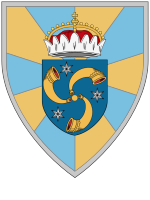
The Carnovian Armed Forces consists of its citizens (volunteers). If necessary, there is a procedure to mobilise all citizens on the orders of the council. The current Prince is the commander-in-chief of Carnovian Armed Forces who partakes in military strategic decisions and promotes other officers into rank of general, to whom members of the forces swear an oath of allegiance, which reports directly to the Prince or the Princely Council. Compulsory military service was introduced from the acquisition of 18 years to half of year. This is militia training, which includes: infantry training and the basics of logistics. Carnovian Armed Forces is managed by the Ministry of Defence and controlled by the General staff of Carnovian Armed Forces, chaired by the Army general. The Carnovian Armed Forces are made up of volumes and formations of several types of forces, namely the Carnovian Land Forces, Carnovian Navy, and the Carnovian Air Forces. The main task of the armed forces is to defend against external attack and to carry out tasks under international treaty obligations relating to common defence or peace and security operations.
Law enforcement and emergency services
Law enforcement in Carnovia is performed by several agencies which are subordinate to the Ministry of Interior - the State Police (Policie), assigned to investigate crimes or transgression; the Municipal City Guard, which maintains public order; and several specialized agencies, such as the Carnovian Border Guard. Private security firms are also common, although they possess no legal authority to arrest or detain a suspect.
The Carnovian Public Security Agency is an armed intelligence agency with an internal field of competence (counterintelligence). This Security Corps obtains, collects and evaluates information relevant to security, the protection of the constitutional order, democratic principles and the important economic interests of the Principality of Carnovia. The Agency was created on 1 March 2022 by a resolution of the Princely Council, to be further defined by law. The activities of the Agency are the responsibility of the Government, which also coordinates its activities. The Prince also has the authority to impose tasks on the service within the limits of its remit. The Agency does not come under any ministry, it is a separate state office. The service budget is a direct part of the state budget. The Agency may only collect information relating to: terrorism, security or significant economic interests of the state activities of foreign intelligence services on our territory intentions or actions directed against the democratic foundations, sovereignty and territorial integrity of Carnovia, organised crime extremism, threats to classified information, cyber security.
Emergency services in Carnovia consist of the emergency medical services, search and rescue units of the Carnovia Armed Forces and State Fire Service. Emergency medical services in Carnovia are operated by local and regional governments, but are a part of the centralized national agency - the National Medical Emergency Service. All emergency services personnel are uniformed and security services can be easily recognized during regular patrols in both large urban areas or smaller suburban localities.
Princely Honor Guard of Carnovia
The Princely Honor Guard is a division level unit in the Carnovia Army which is the seniormost unit in the Carnovian Armed Forces that has the responsibility of defending the prince and national institutions. It is a type of guard regiment that is composed of dozens upon dozens of armored brigades, mechanized brigades and divisional artillery, Being the seniormost unit in the armed forces. Formally the Honor guard is part of army, but receive orders from the prince and his office.
Civil Service
The Civil Service carries out police activities in the fields of protection of citizens' life and health, protection of public order, investigation of criminal offences, supervision of road traffic, etc. It is a branch of the Corps for the Protection of the Public Welfare of Carnovia. The CS is directly under the responsibility of the Carnovian Ministry of the Interior and is divided into the public-administrative, forensic, transport and guard sectors.
Foreign affairs
Principality of Carnovia opened its first diplomatic division on 1 January 2022.
Carnovia is successor state of Archduchy of Egeria and inherited all its diplomatic relations with other nations and organizations. It is so because National Assembly of Egeria declared this inheritance edict and Carnovian Princely Council later on accepted this change.
21 November 2021 Carnovia inherited full membership in Grand Unified Micronational after meeting all requirements and singing the GUM charter. Principalitie's policy within GUM is to aim for new diplomatic relations, cooperation with other member state, fulfilment of duties and maintaining peace and stability. There are two operating delegates, one of them being his Princely Highness Peter I of Carnovia. Prince is convinced that head of state should represent the country on this scale.
Formal relation states
Recognised states; no foreign relations
 Certain UN member states
Certain UN member states GUM All members
GUM All members Kosovo
Kosovo Taiwan
Taiwan Cook Islands
Cook Islands Catalonia
Catalonia Transnistria
Transnistria Republic of Artsakh
Republic of Artsakh Somaliland
Somaliland Gagauzia
Gagauzia
Organizations
| Organization | Date | Type of relation |
|---|---|---|
| 21 November 2021 | Full membership |
Geographical data

Carnovia borders the Czech Republic and the Republic of Poland.
Carnovia has one main river flowing through its teritority called Opava, which flows from Carnovia across Czech Republic and Polish Republic. It is 110 km long. The highest natural point is Polomy, hill at 725 m. Carnovia is surrounded by Jeseník mountains (Czech:Hrubý Jeseník) from north and has hilly terrain to flat terrain in south.
Phytogeographically, the Carnovia belongs to the Central European province of the Circumboreal Region, within the Boreal Kingdom.
Climate
Carnovia has a temperate climate, situated in the transition zone between the oceanic and continental climate types, with warm summers and cold, cloudy and snowy winters. The temperature difference between summer and winter is due to the landlocked geographical position. Temperatures vary depending on the elevation. In general, at higher altitudes, the temperatures decrease and precipitation increases.
The coldest month is usually January, followed by February and December. During these months, there is snow in the mountains and sometimes in the cities and lowlands. During March, April, and May, the temperature usually increases, especially during April, when the temperature and weather tends to vary during the day. Spring is also characterized by higher water levels in the rivers, due to melting snow with occasional flooding.
The warmest month of the year is July, followed by August and June. On average, summer temperatures are about 20–30 °C (36–54 °F) higher than during winter. Summer is also characterized by rain and storms.
Autumn generally begins in September, which is still warm and dry. During October, temperatures usually fall below 15 °C (59 °F) or 10 °C (50 °F) and deciduous trees begin to shed their leaves. By the end of November, temperatures usually range around the freezing point.
Culture

The Culture of the Principality of Carnovia is similar to that of the Czech Republic in terms of language, traditions, cuisine, holidays and religion. The primary language is Czech and is the official language of the Principality of Carnovia, while the other official languages are Slovak and English. They are mostly used in the territory of the Carnovia. Most holidays are taken from Czech culture, but few of them are their own.
Architecture
The oldest preserved building of Carnovia dates back to the first half of the 13th century and it is the church of St. Benedict of Nursia. Today it serves as a parish of the Roman Catholic Church and is also a protected monument. It contains frescoes from the 13th and 15th centuries, which depict scenes from the life of St. Benedikt of Nursia and the Transfiguration on Mount Tábor and in 2001–2007 were restored. On the main altar is a painting of St. Benedict baptizes a dead boy from 1780 by František Antonín Sebastini. Since the Middle Ages, the Carnovian lands have been using the same architectural styles as most of Western and Central Europe. The oldest still standing churches were built in the Romanesque style. During the 13th century, it was replaced by the Gothic style. The Renaissance style penetrated the Carnovia in the late 15th century when the older Gothic style started to be mixed with Renaissance elements. The most important architectural styles were the Baroque and Art Nouveau and the main representatives are Eduard Frank and Ernst Latzel. Under the influence of these two architects, the real flourishing of Carnovia began.
Media

Carnovian journalists and media enjoy a degree of freedome. There are restrictions against writing in support of Nazism, racism or violating Carnovian law. The national public television service is Carnovian National Television (Czech: Krnovská národní televize) that operates the news channel 1KNT and is the most watched television in Carnovia. It was founded on 27 February 2022 as a mean of communication, where Government can inform citizens about various events. Carnovian National Television cooperates strongly with Central Government, so instead of having own websites, all the articles can be found on websites of Government and its official Facebook and Twitter account. National Television has also educational purpouse and broadcast many interesting events from history. It is funded through television concession fees which are paid by all households and legal entities that own a television or any form television signal receiver.
Cuisine
cuisine is marked by an emphasis on meat dishes with pork, beef, and chicken. Goose, duck, rabbit, and venison are served. Fish is less common, with the occasional exception of fresh trout and carp, which is served at Christmas. There is also a variety of local sausages, wurst, pâtés, and smoked and cured meats. Egerian desserts include a variety of whipped cream, chocolate, and fruit pastries and tarts, crêpes, creme desserts and cheese, poppy-seed-filled and other types of traditional cakes such as buchty, koláče and štrúdl. Very popular is mineral water and carbonated water or Beer.
Public holidays
| Date | Holiday | Overview |
|---|---|---|
| 31.December - 1. January | New Year | Celebration of the end of year and the new one. |
| 6. January | Tree Kings | The end of the celebration of Christ's birth in evangelical and Catholic liturgy. |
| 7. January | The birth of the Lord | In the Orthodox liturgy, the celebration of the birth of Jesus Christ |
| Movable | Good Friday | Christian holiday. Commemoration of the crucifixion of Jesus Christ |
| Movable | Easter Monday | Christian holiday. It follows the Resurrection of the Lord on Sunday. |
| 1.May | Labor day | Remembering the 1886 labor strike in Chicago. |
| 5.July | The day of Cyril and Methodius | The arrival of the prophecies of Cyril and Methodius at Great Moravia in 863. |
| 6.July | The Day of Burning of Master Jan Hus | The Burning of Priest and Reformer Master Jan Hus during the Constabulary of the Year 1415. |
| 28.September | St Wenceslas Day | The assassination of Prince Wenceslas in Old Boleslav |
| 17.November | The Day of the Fight for Freedom and Democracy | A commemoration of the student demonstrations and the subsequent closure of Czech universities by German occupiers in 1939 and the student demonstration of 1989, which launched the Velvet Revolution. |
| 21.November | Independence Day | Declaration of Independence of the Principality of Carnovia on 21 November 2021 |
| 24.December | Christmas Eve | The Evening Celebration of Christmas. |
| 25.December | The 1st feast of Christmas | In the Catholic and Evangelical liturgy, the celebration of the birth of Jesus Christ. |
| 26.December | Boxing Day | In the Catholic and Evangelical liturgy, a commemoration of the first Christian martyr, Stephen. |
See also
- Constitution of Carnovia
- Collection of regulations of Carnovia Principality
- Peter I, Prince of Carnovia
External links
Notes
References
- ↑ The Princely Council. "Princely Decree 17/2022 Sb". Archived from the original on 9 March 2022.
- ↑ Blucha. Stručné dějiny města Krnova. Krnov-Hlubčice Virtual Museum. http://muzeum.krnov.cz/download.asp?file=_download/knihy/strucne_dejiny_krnova.pdf.
- ↑ Carlyle, Thomas (1858). History of Friedrich II of Prussia, Called Frederick the Great. Book III. http://onlinebooks.library.upenn.edu/webbin/gutbook/lookup?num=2103.
- ↑ The Princely Council. "Constitution 1/2021 Sb". Archived from the original on 1 March 2022.
- ↑ The Princely Council. "District act 5/2022 Sb". Archived from the original on 1 March 2022.
- ↑ The Princely Council. "State symbols act 6/2022 Sb". Archived from the original on 1 March 2022.
- ↑ The Princely Council. "State citizenship act 8/2022 Sb". Archived from the original on 1 March 2022.
- ↑ The Ministry of Foreign Affairs. "Treaty of Mutual Recognition Vishwamitra". Archived from the original on 1 March 2022.
- ↑ The Ministry of Foreign Affairs. "Treaty of Mutual Recognition Nexan Republic". Archived from the original on 1 March 2022.
- ↑ The Ministry of Foreign Affairs. "Treaty of Mutual Recognition Esgeldia". Archived from the original on 4 March 2022.
- ↑ The Ministry of Foreign Affairs. "Treaty of Mutual Recognition Sancratosia". Archived from the original on 5 March 2022.
- ↑ The Ministry of Foreign Affairs. "Treaty of Mutual Recognition Mendersia". Archived from the original on 5 March 2022.


